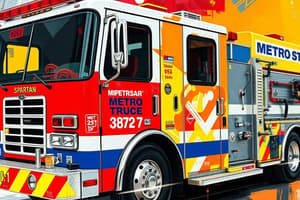Podcast
Questions and Answers
What does engine size, measured in cubic centimeters (cc) or cubic inches (ci), determine?
What does engine size, measured in cubic centimeters (cc) or cubic inches (ci), determine?
- The weight of the engine
- The shape of the engine
- The volume of air and fuel a combustion chamber can hold (correct)
- The number of cylinders in the engine
In general, what does a higher engine displacement indicate?
In general, what does a higher engine displacement indicate?
- More power potential (correct)
- Smaller combustion chamber
- Higher fuel efficiency
- Lower power potential
Which engine is likely to provide a more spirited driving experience: a 2.0L engine or a 1.6L engine?
Which engine is likely to provide a more spirited driving experience: a 2.0L engine or a 1.6L engine?
- It depends on the cylinder count
- 1.6L engine
- Both provide the same driving experience
- 2.0L engine (correct)
What do cylinders in an engine serve as?
What do cylinders in an engine serve as?
Which type of engine configuration consists of two rows of cylinders arranged horizontally?
Which type of engine configuration consists of two rows of cylinders arranged horizontally?
What is the main difference between V-type and Boxer engines?
What is the main difference between V-type and Boxer engines?
What impact can the arrangement of cylinders have on an engine's performance?
What impact can the arrangement of cylinders have on an engine's performance?
How does a higher compression ratio affect engine performance?
How does a higher compression ratio affect engine performance?
What role does horsepower play in a vehicle's acceleration?
What role does horsepower play in a vehicle's acceleration?
Which factor contributes to better fuel economy in a vehicle?
Which factor contributes to better fuel economy in a vehicle?
What aspect of engine design typically affects the driving experience of a vehicle?
What aspect of engine design typically affects the driving experience of a vehicle?
How does a high horsepower rating affect the speed capabilities of a sports car?
How does a high horsepower rating affect the speed capabilities of a sports car?
Flashcards are hidden until you start studying
Study Notes
Exploring Engine Specifications
Engine specifications form the bedrock of understanding the capabilities and performance of vehicles. By delving into three key aspects of engine design—engine size, cylinder type, and horsepower—we can uncover the heart of what makes an engine tick.
Engine Size
Engine size, typically measured in cubic centimeters (cc) or cubic inches (ci) for internal combustion engines, dictates an engine's displacement—the volume of air and fuel a combustion chamber can hold. A higher displacement engine usually means more power potential, as it can draw in and burn more fuel.
For instance, a 2.0L (liter) engine, which is approximately 122 cubic inches, may provide a more spirited driving experience than a 1.6L (100 cubic inches) engine. However, this isn't a hard-and-fast rule, as other factors like cylinder count and valvetrain can also influence power output.
Cylinder Type
Cylinders are the chambers in which fuel and air are mixed and combusted. In general, engines have one of three cylinder configurations:
- In-line: Engines with one row of cylinders, like four-cylinder or six-cylinder units.
- V-type: Engines with two rows of cylinders, creating a "V" shape, with a 90-degree angle between the rows (such as a V6) or a 60-degree angle (like a V8).
- Boxer: Engines with two rows of cylinders, arranged horizontally, creating a "boxer" shape, as seen in some Porsche and Subaru engines.
The type of cylinder and its arrangement can greatly impact an engine's performance, handling, and overall feel. For example, an in-line motor may provide a smoother ride, while a V-type engine often brings better power output and a more aggressive driving experience.
Horsepower
Horsepower (hp) represents an engine's power output, or the rate at which an engine can perform work. This measurement is important, as it determines how fast an engine can accelerate a vehicle and, ultimately, how quickly it can reach highway speeds.
The number of horsepower an engine produces can influence its acceleration, top speed, and overall driving experience. For instance, a sports car with a high horsepower rating can accelerate faster and reach higher speeds, while a family sedan with a lower horsepower rating may be more fuel-efficient and offer a smoother, more comfortable ride.
Factors that Affect Engine Performance
Besides the aforementioned aspects, several other factors contribute to an engine's performance and capabilities. These include:
- Compression ratio: The ratio between the volume of a cylinder when the piston is at the bottom of its stroke (intake) and at the top (compression). Higher compression ratios allow for more efficient combustion, leading to better performance.
- Valvetrain: The system that opens and closes the engine's intake and exhaust valves. A more efficient valvetrain can lead to better performance and fuel economy.
- Fuel and air intake: The system used to deliver fuel and air to the engine. High-flow intake systems can lead to better performance and acceleration.
- Exhaust system: The system used to remove exhaust gases from the engine. High-performance exhaust systems can lead to better performance and fuel efficiency.
By understanding engine specifications and how they relate to these other factors, you'll gain a deeper appreciation for automotive engineering and what makes a vehicle go.
Studying That Suits You
Use AI to generate personalized quizzes and flashcards to suit your learning preferences.




